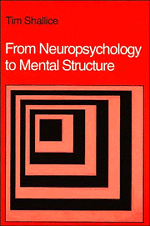Book contents
- Frontmatter
- Contents
- Preface
- I Introducing Cognitive Neuropsychology
- II Converging Operations: Specific Syndromes and Evidence from Normal Subjects
- III Inferences from Neuropsychological Findings
- IV Central Processes: Equipotentiality or Modularity?
- References
- Subject Index
- Author Index
- Index of Patients Cited
- Frontmatter
- Contents
- Preface
- I Introducing Cognitive Neuropsychology
- II Converging Operations: Specific Syndromes and Evidence from Normal Subjects
- III Inferences from Neuropsychological Findings
- IV Central Processes: Equipotentiality or Modularity?
- References
- Subject Index
- Author Index
- Index of Patients Cited
Summary
Interest in neuropsychology has increased greatly over the past 20 years. This has mainly occurred for direct clinical reasons, such as the increase in the ability of neuropsychological investigations to assess the crippling problems in thought, memory, and language that can occur from brain damage. There is, though, a second reason for the increase of interest in the subject. The human brain is still the organ we understand least well, and the process by which its highest function – cognition – operates remains mysterious. The dramatic effects of brain damage appear to provide valuable evidence about how the systems underlying cognition operate. The aim of this book is to assess this evidence. Is neuropsychological evidence of any real value in understanding normal cognition? If so, what form or forms should this evidence take, and what substantive conclusions can be drawn?
The relevance of neuropsychological findings remains controversial because neuropsychology – in a somewhat parallel fashion to psychology – has rejected much of its former doctrines in virtually every generation. The approach that is the subject matter of this book, cognitive neuropsychology, is hardly a generation old. In many respects, cognitive neuropsychology seems very healthy. Interest in it is increasing rapidly, and surprising findings are frequently being made. Yet its practitioners use conflicting methodologies, each of which balances on a set of barely examined assumptions.
In the 1970s, I wrote two articles (Shallice, 1979a, 1979b) that assessed, in a positive fashion, a methodological approach then unfashionable within neuropsychology – the single-case study.
- Type
- Chapter
- Information
- From Neuropsychology to Mental Structure , pp. xiii - xviPublisher: Cambridge University PressPrint publication year: 1988



